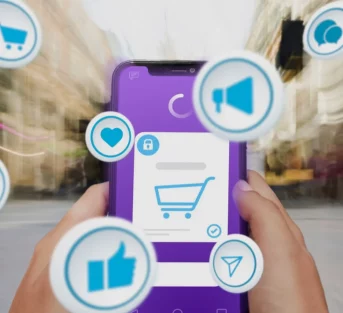The e-commerce scenario is a roller-coaster ride, driven by rapid advancements in technology, shifting consumer preferences, and lively emphasis on sustainability. With AI-powered personalization, flawless omnichannel experience, and eco-conscious practices hugging the limelight, opportunities for entrepreneurs are vast and juicy.
For today’s consumers convenience is not the final word. Now add authenticity, innovation, and impact to it. In this blink-and-miss environment, staying ahead means tapping into emerging trends and identifying niche markets with growth potential.
Our blog explores some promising, creative and profitable ecommerce business ideas set to thrive in 2025. Whether you’re a budding entrepreneur or an established seller looking to pivot or scale, these insights will help you navigate and seize the best moves of digital commerce.
TL;DR
- Sustainable & Eco-Friendly Products
- Rising demand for reusable items, organic textiles, and biodegradable packaging.
- Stats: 73% of consumers prefer sustainable brands (Nielsen).
- Tools: Shopify, EcoCart, Printify.
- Examples: Blueland ($20M revenue), Package Free Shop.
- Subscription Models
- Recurring revenue, high retention (15% of shoppers use subscriptions).
- Niches: Wellness boxes, meal kits, digital content.
- Tools: Subbly, Cratejoy, Recharge Payments.
- Dropshipping & Print-on-Demand
- Low-risk entry; no inventory needed.
- Platforms: Shopify, Printful, AliExpress.
- Growth hack: Use TikTok/Instagram for organic traffic.
- Health & Wellness Boom
- $5.6T market; focus on supplements, fitness gear, clean beauty.
- Example: Care/of (personalized vitamins).
- Tech-Driven Trends
- AI personalization (e.g., Stitch Fix), AR/VR shopping (e.g., IKEA Place).
- Custom & Personalized Products
- Commands 30-50% premium pricing.
- Tools: Zakeke, Printful.
- Example: Function of Beauty (custom haircare).
Key Takeaway: Blend sustainability, tech, and personalization for a profitable eCommerce venture in 2025.
Sustainable and Eco-Friendly Product Lines
The Rise of Conscious Consumerism
When it comes to buying, there’s been a dramatic shift in consumer behavior. Shoppers are now prioritizing sustainability and are not just aiming for quality and affordability, this is conscious consumerism. Many buyers now base their purchase decisions on a product’s social, environmental, and ethical impact.
- Market Trends:
- According to a Nielsen report, 73% of global consumers vouch to change their consumption habits to reduce environmental impact.
- Gen Z and Millennials are leading the charge, with 62% of Gen Z preferring to buy from sustainable brands (First Insight report).
- The eco-conscious product market is projected to grow to $150+ billion by 2026.
- A study by IBM and the National Retail Federation found that 57% of consumers are willing to alter their purchasing habits to reduce detrimental environmental repercussions.
What This Means for Entrepreneurs: The environment-conscious market will continue to grow. Founders can build profitable businesses by aligning with sustainability trends and make a positive impact as well. This signals a huge opportunity for planet-friendly entrepreneurs to build businesses aligned with these values.
Key Product Categories
The demand for green alternatives spans multiple industries. Here are some product categories:
Reusable Items
- Examples: Reusable straws, beeswax food wraps, shopping bags, silicone storage bags, and menstrual cups.
- Startup Tip: Start small with a few SKUs and use Instagram Reels or TikTok to showcase real-world benefits.
- Tools to Use: Shopify for store setup, EcoCart to offer carbon-neutral checkout, Oberlo/Spocket for eco-conscious product sourcing.
- Why They Work: These products reduce single-use waste and appeal to environmentally conscious buyers.
Organic Textiles
- Examples: Clothing (T-shirts, bedding, towels) made from organic cotton, bamboo, or hemp.
- Brand Inspiration: Pact – Focuses on creating comfortable and sustainable everyday apparel, prioritizing organic cotton and transparent supply chains. They aim to become “Earth’s Favorite Clothing Company” emphasizing sustainable practices and carbon offsetting. They use non-GMO organic cotton and improve the lives of farmers and workers in their supply chain.
- Why They Work: Shoppers are increasingly aware of the impact of fast fashion. Organic materials use less water and fewer chemicals.
Biodegradable Packaging
- Examples: Compostable mailers, packing peanuts made from cornstarch, and biodegradable bubble wrap.
- Examples: Compostable mailers, sustainable bathroom essentials, shaving kits.
- Why They Work: E-commerce businesses using sustainable packaging can set themselves apart with minimal environmental impact.
Successful Business Examples:
- Package Free Shop: A zero-waste lifestyle brand offering eco-friendly everyday essentials.
- Brand Inspiration: Blueland –Their range of cleaning products are in the form of tablets that dissolve in water to create concentrated cleaning solutions. This reduces plastic waste associated by eliminating the need for single-use plastic bottles. Their revenue last year amounted to $20M.
- Tentree: They combine sustainable apparel with tree planting initiatives. They aim to inspire clean environs by offering quality, earth-conscious clothing and planting ten trees for every item sold, with a goal of planting one billion trees by 2030. Their sustainable clothing appeals to Millennials and Gen Z.
💡 Startup Tip: Highlight certifications like “GOTS Certified Organic,” “Plastic-Free,” “Compostable,” or “B Corp” to build trust.
Platforms and Tools:
- Shopify (with sustainability plugins)
- Printify + Eco-friendly products
- Grove Collaborative (for wholesale eco products)
- Planet App for Shopify – Offers carbon-offset shipping.
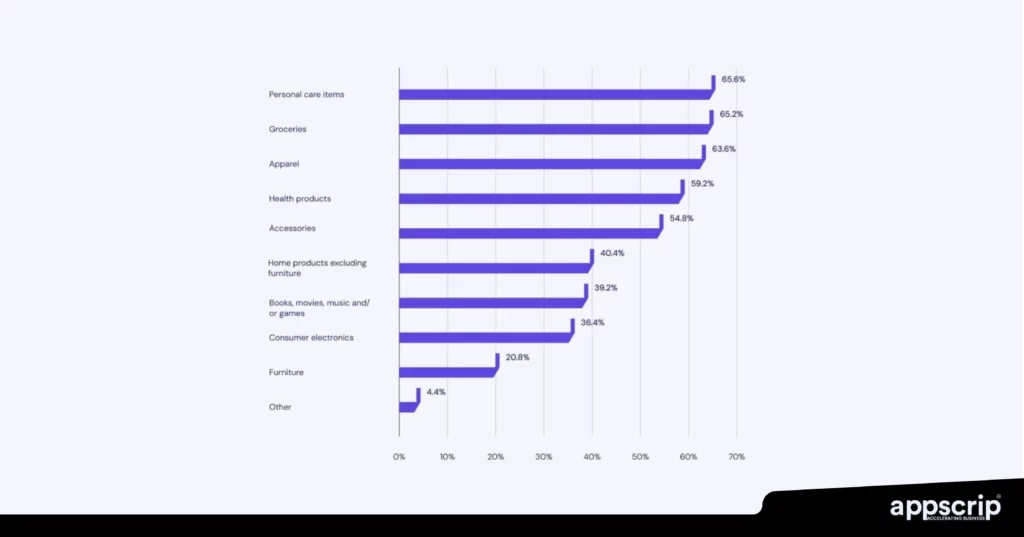
Top product categories sold last year in percentage
Subscription-Based Business Models
Why Subscriptions Work
The subscription model brings in recurring revenue, scalable opportunities, and predictable growth. It’s effective in categories where personalization and convenience bring loyalty.
The subscription model dominates eCommerce revenue model due to predictable revenue and long-term customer relationships. Here are other reasons that make it attractive:
- Recurring Revenue Stream: Unlike one-time sales, subscriptions provide consistent monthly or yearly income, helping with cash flow and business planning.
- Improved Customer Retention: Brands can nurture relationships, upsell additional products, and regular touchpoints builds loyalty.
- Data-Driven Personalization: Subscription services can collate usage and preference data, enabling highly personalized experiences.
- Lower Customer Acquisition Costs Over Time: Once acquired the lifetime value (LTV) of a customer outweighs the cost, especially if churn is low.
📈 According to Zuora, companies with subscription models grow revenues about 5x faster than the S&P 500 average.
- Key Benefits for Founders:
- Stable monthly cash flow.
- High customer lifetime value.
- Easier inventory planning.
- Ability to build tight-knit communities around your brand.
- Consumer Preferences:
- A McKinsey study shows 15% of online shoppers have signed up for one or more subscriptions, mostly for curated and convenience-driven products.
- By 2026 the global subscription eCommerce market is set to hit $904.2 billion.
Popular Subscription Niches
Entrepreneurs preferring this space can consider several fast-growing niches:
Wellness Boxes
- Examples: Self-care kits, vitamins, supplements, aromatherapy, menstrual wellness kits.
- Why It Works: Wellness is a growing industry, and curated monthly boxes offer value and excitement.
- Profit Margins: ~60–70%
- Example Brand: TheraBox – Each TheraBox offers self-care products with therapeutic value that include 6-8 hand-picked items, not available in the market. Categories include aromatherapy, sleep aids, wellness products, personal care, journals, incense, jewelry and more.
- TheraBox works with cruelty-free, mission-driven brands with a unique voice, they are earning 6-figure monthly revenues within a couple of years.
Meal Kits
- Examples: DIY dinner kits, smoothies, organic snacks, ethnic cuisines.
- Why It Works: Consumers value the convenience of meal prep to the ennui of shopping.
- Profit Margins: ~25–50%
- Example Brand: Blue Apron – This meal kit delivery service sends customers pre-portioned ingredients and recipes for home cooking. They offer a variety of meal plans, wherein customers can choose the number of recipes they receive each week. Their business model relies on subscription service, where customers pay a recurring fee for their chosen meal plan.
Digital Subscriptions
- Examples: E-books, productivity tools, niche education platforms, stock content, templates.
- Why It Works: Zero shipping, scalable, high margins.
- Profit Margins: 70–90%
- Example Brand: MasterClass – A “masterclass” can refer to a class taught by an expert. It’s a learning experience where you learn from someone with deep knowledge and experience in a specific field, like music, art, or cooking. Their business model works on a recurring annual plan.
Startup Tools and Platforms:
- Subbly – Subscription-first platform with ready-made tools for billing, customization, logistics, storefront and analytics.
- Cratejoy – Great for visibility, analytics, and community features.
- Recharge Payments – Seamless Shopify integration for recurring billing.
- Bold Subscriptions – Excellent for advanced Shopify stores.
💡 Growth Hack: Offer tiered plans or seasonal bundles to increase average order value (AOV) and reduce churn.
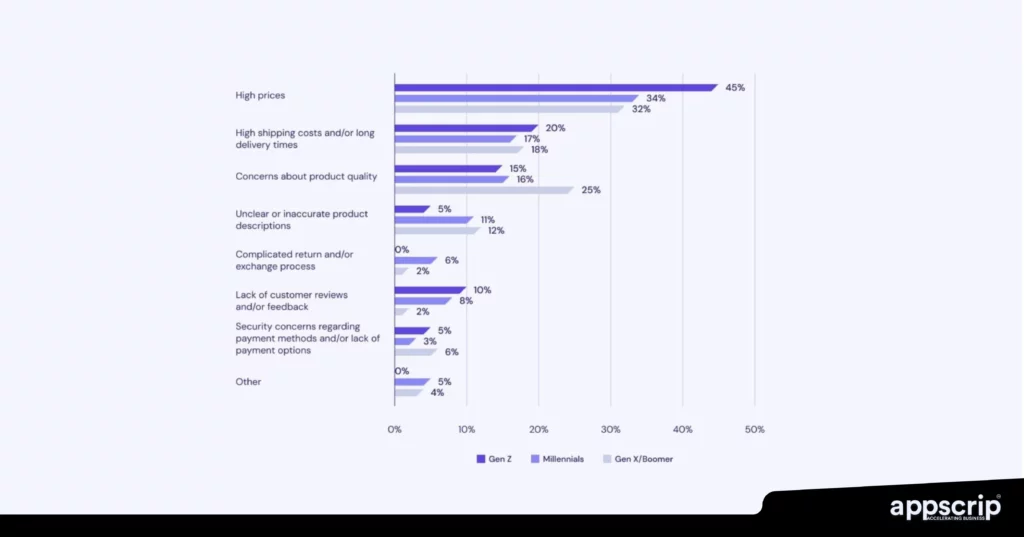
Price sensitivity, Discounts and other reasons for cart abandonment
Dropshipping and Print-on-Demand Models
Low-Risk Entry Points
Dropshipping and Print-on-Demand (POD) are for entrepreneurs with limited capital. You only sell products on your eCommerce store, while third-party suppliers fulfill orders and ship directly to customers. That allows you to operate without storing inventory.
- Dropshipping:
- Products are sourced from suppliers (like AliExpress or Oberlo).
- No need to purchase inventory upfront.
- There are unlimited possibilities.
- Print-on-Demand (POD):
- Products (like t-shirts, mugs, tote bags) are printed only after the customer places an order.
- Ideal for artists, designers, or content creators who want to monetize their creativity.
🌱 These models allow startups to test products quickly and scale based on real customer demand.
Success Tips for New Entrepreneurs
Here’s how to make the most of these business models:
Choosing the Right Products:
- Start with something you know well or are passionate about.
- Use tools like Google Trends, Sell The Trend, or Ecomhunt to identify trending products.
- It is best to focus on low-competition, high-margin items.
Finding Reliable Suppliers:
- Use AliExpress, Spocket, Zendrop, or DSers for dropshipping.
- Use Printify, Printful, or Gooten for print-on-demand.
- Test suppliers by ordering samples to check product quality and shipping speed.
Platforms to Launch Your Store:
- Shopify: Easiest for beginners, with powerful integrations for dropshipping and POD.
- WooCommerce (WordPress): More customizable but requires more setup.
- BigCommerce: Good for scaling as you grow.
Bonus Tools:
- Canva: For creating POD designs.
- DSers: For AliExpress dropshipping automation.
- Plug in SEO and Judge.me: For boosting Shopify store performance.
💡 Startup Tip: Focus on strong branding and content marketing (e.g., Instagram, TikTok, or Pinterest) to build a loyal audience and drive traffic without hanging on to paid ads.
Health and Wellness Products
A Booming Industry
In 2024, the global wellness market hit $5.6 trillion. COVID-19 set the stage for a health-cum-fitness revival as consumers prioritized health, longevity, and self-care. This brought in keenness for physical wellness, mental well-being, nutrition, and personal care.
Profitable Product Examples:
- Supplements – Vitamins, nootropics, and immunity boosters.
- Fitness Gear – Resistance bands, smart wearables, yoga mats.
- Organic & Clean Beauty Products – Skincare without harmful chemicals.
- Health-focused Beverages – Kombucha, cold-pressed juices.
Startup Tips:
- Focus on transparency and certifications (e.g., GMP, organic).
- Build trust through customer reviews and testimonials.
- Start lean with dropshipping or white-labeling to test product-market fit.
Platforms & Tools:
- Shopify with health-centric themes.
- Gempages for building high-converting landing pages.
- Yotpo for user-generated reviews and loyalty.
Real-life Example:
- Care/of: The is a personalised vitamin and supplement subscription service that grew rapidly using a direct-to-consumer (DTC) model and strong branding. They provide customized recommendations based on individual needs and preferences, determined by an online questionnaire.
Opportunities in Niche Markets
Niche Ideas:
- Mental Health Products – Journals, stress-relief gadgets, guided meditation apps.
- Holistic Wellness – Ayurvedic remedies, essential oils, herbal teas.
- Sustainable Living – Reusable wellness items, biodegradable packaging, plant-based supplements.
Startup Tips:
- Tap into communities (e.g., Reddit, wellness forums) for real feedback and early traction.
- Consider subscription models for consistency and customer retention.
- Collaborate with micro-influencers in wellness for promotions.
Tools & Platforms:
- Cratejoy for subscription box businesses.
- Google Trends for niche research.
- Klaviyo for email marketing automation.
Example:
- Moon Juice: Moon Juice helps individuals practise a holistic lifestyle that goes far beyond juices, milks, and snacks. They’ve built a cult following with adaptogenic supplements marketed to wellness-conscious millennials. It’s specially marketed to those seeking out beauty, wellness and longevity.
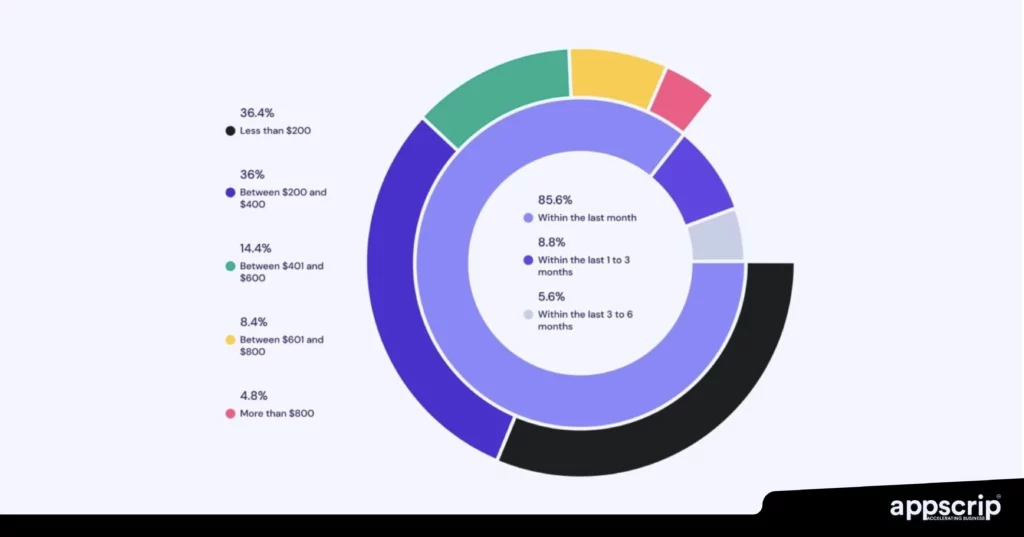
Online purchase timing and last month spend
Technology Integration in eCommerce
AI and Personalization
Benefits of AI: AI helps businesses better understand customers, make data-driven decisions, and provide more efficient and engaging online shopping experiences.
AI improves the shopping experience by automating processes, customising the customer journey, improving customer service, optimizing sales strategies, boosting conversions, and upselling intelligently.
Examples:
- Product recommendations (like Amazon or Netflix-style “You might also like”).
- Chatbots powered by NLP for 24/7 customer support (e.g., Tidio, Drift).
- AI-driven analytics to predict customer behavior and optimize inventory.
Startup Tips:
- Implement basic personalization early using tools like Nosto or Dynamic Yield.
- Use predictive analytics for retargeting high-potential users.
- 70%+ of traffic is mobile, therefore prioritize mobile personalization.
Example:
- Stitch Fix: Stitch Fix is an online personal styling service that delivers curated clothing and accessories to customers based on their style preferences and feedback.
- Customers complete a style questionnaire and stylists, aided by AI, select five items from a variety of brands, which are then shipped to the customer.
- Customers try on the items at home, keep what they like, and return the rest with a prepaid label. If a customer keeps at least one item, a styling fee is credited towards the purchase.
Immersive Shopping Experiences
Use of AR/VR: AR/VR technologies literally bring brick-and-mortar experiences online. They enhance the shopping experience by allowing customers to virtually visualize products, interact with them, and explore retail spaces. This helps cut returns and improves customer satisfaction.
Applications:
- AR try-ons for fashion (e.g., Warby Parker, Sephora).
- 3D product views for furniture (e.g., IKEA Place).
- Virtual showrooms to simulate a real-world store visit.
Startup Tips:
- Start with WebAR (e.g., 8thWall or Zappar) before diving into full VR.
- Use platforms like Shopify AR to create immersive product experiences.
- Educate users with interactive tutorials or demos.
Example:
- Houzz: Houzz connects homeowners and home design enthusiasts with professionals in the home improvement industry. It’s a one-stop-shop for finding inspiration, products, and professionals to help with home renovation and design projects. They saw an 11x increase in conversion rates with its AR feature allowing users to see furniture in their space.
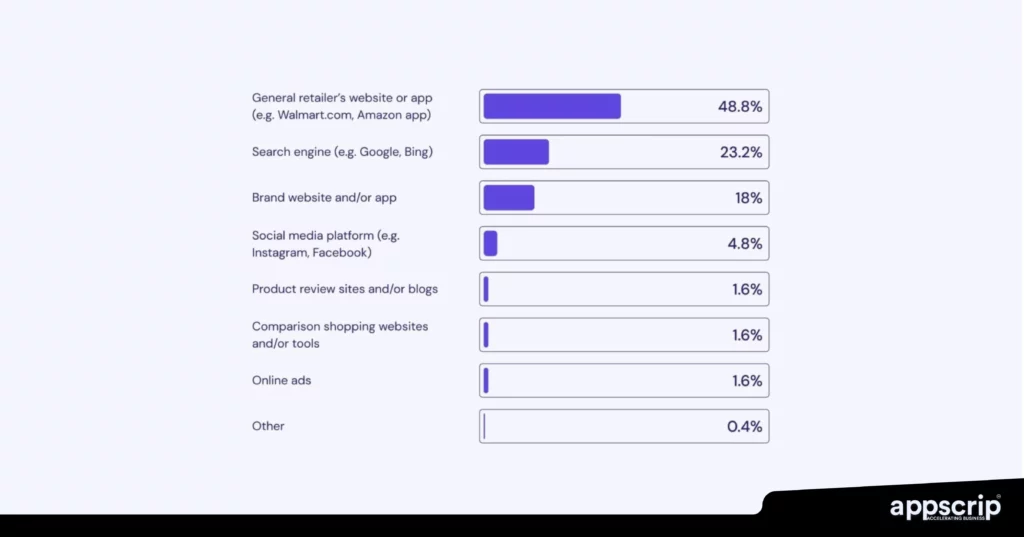
Starting point for online shopping
Personalized and Custom Products
Meeting Consumer Desire for Unique Items
Why It Works: Consumers love individuality, they feel proud to own products that are exclusive. And they are ready to spend a bomb for it. Personalized products resonate because they offer a sense of identity, emotional connect, and exclusivity. In fact, over 70% of shoppers say they’re more likely to purchase from brands that offer personalization.
Examples of In-Demand Custom Products:
- Custom Jewelry – Name necklaces, birthstone rings, coordinates bracelets.
- Home Decor – Personalized wall art, monogrammed cushions, custom maps.
- Pet Products – Pet portraits, name tags, breed-specific accessories.
- Stationery & Gifts – Wedding favors, engraved pens, photo books.
Startup Tips:
- Start with print-on-demand to minimize inventory risk.
- Use product customizers (like live previews) on your site.
- Offer limited-edition personalization (e.g., seasonal, occasion-based).
Platforms & Tools:
- Zakeke or Teeinblue (for live product customization on Shopify).
- Printful or Printify for white-label production and dropshipping.
- Etsy as a launchpad for niche custom items.
Real-life Example:
- Notonthehighstreet: This online marketplace connects customers with thousands of small, independent businesses. They specialize in selling unique, handmade, and often personalized items, including gifts, home goods, fashion, and more.
- Their mission is to help customers discover and support small brands. They focus on bespoke gifts and custom goods, finding consumers looking for thoughtful, non-mass-produced items.
Leveraging Premium Pricing
The Value of Customization: Customized products are worth 30-50% higher than the standard version due to their perceived value. Customers will pay more for products that reflect their unique personality, commemorate a memory, or love a “made just for them” feeling.
How to Implement in eCommerce:
- Tiered Pricing Models – Offer basic, semi-custom, and fully custom versions.
- Use interactive design tools that let customers co-create.
- Showcase customer stories or user-generated content to highlight uniqueness.
Startup Tips:
- Position your product as personalised and gift-worthy— as it thrives in this category.
- Highlight emotional value and perceived value in your product descriptions and ads.
- Invest in packaging and unboxing—personalized items feel even more special with a premium feel.
Platforms & Tools:
- Kickflip (product personalization software for Shopify, WooCommerce).
- Gooten for backend fulfillment of custom products.
- Canva Pro for creating on-brand mockups, packaging inserts, and customer thank-you notes.
Example:
- Function of Beauty: Provides customized beauty products, particularly for hair, skin, and body care. They focus on freshly formulated, customized hair care, including mix-your-own custom shampoos and conditioners.
- Personalize products based on individual hair and skin goals, offering a unique experience. You can even name your bottle—leading to strong brand loyalty and premium pricing.
Conclusion: Profitable Ecommerce Business Ideas
The world of eCommerce is a beehive of opportunity. The ideas we have explored here — from health and wellness to personalized products — indicate how tech integration, consumer trends, and innovation can shape profitable ventures.
Entrepreneurs who can blend creativity with data-driven insights can carve a unique, lucrative, and sustainable niche for themselves. As the eCommerce landscape scampers, use the right tools, strategy, and mindset, to turn your dreams into a thriving online business.


